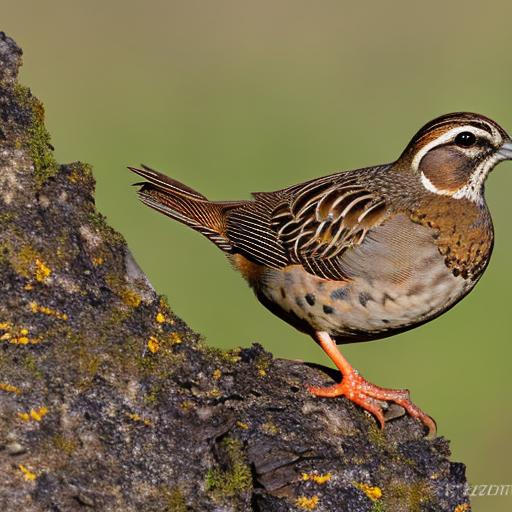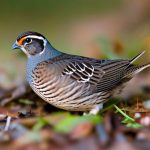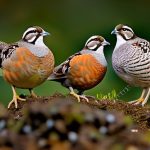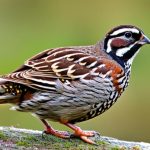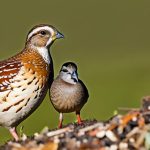Quails are small, ground-dwelling birds that are known for their social behavior and tendency to form flocks. They are also known for their skittish nature and ability to quickly take flight when startled. Understanding quail behavior is essential for creating a suitable environment for them. Quails are diurnal birds, meaning they are most active during the day and rest at night. They are also known to be ground-nesters, meaning they build their nests on the ground rather than in trees or other elevated locations. Quails are also highly social birds and prefer to live in groups, known as coveys. These coveys can consist of several birds and are typically led by a dominant male. Quails are also known for their foraging behavior, as they spend much of their time searching for food on the ground. Understanding these behaviors is crucial for creating a suitable enclosure and providing for their needs.
Quails are also known for their skittish nature and tendency to take flight when startled. This behavior is a natural defense mechanism that helps them evade predators in the wild. When designing an enclosure for quails, it’s important to take this behavior into account and create a secure environment that minimizes stress and disturbances. Additionally, quails are known to be sensitive to changes in their environment, so it’s important to minimize disruptions and provide a stable and predictable living space for them. By understanding these natural behaviors, quail owners can create an environment that meets the birds’ needs and allows them to thrive.
Key Takeaways
- Quail are ground-dwelling birds that prefer to stay in small groups and are easily stressed by disturbances.
- A secure enclosure for quail should have a solid bottom, secure fencing, and protection from predators.
- Quail need a diet of seeds, insects, and greens, and access to clean water at all times.
- Minimize stress and disturbances by keeping noise levels low and limiting human interaction.
- Clipping the wings of quail can prevent them from flying away and getting lost or injured.
Creating a Secure Enclosure
Creating a secure enclosure is essential for keeping quails safe from predators and providing them with a suitable living space. When designing an enclosure for quails, it’s important to consider their natural behaviors and habitat preferences. Quails are ground-dwelling birds that prefer open spaces with access to cover, such as shrubs or tall grass, where they can hide from predators. The enclosure should be spacious enough to allow the birds to move around freely and engage in natural behaviors such as foraging and dust bathing. Additionally, the enclosure should be constructed with materials that are predator-proof, such as wire mesh or hardware cloth, to prevent access from predators such as raccoons, foxes, and birds of prey.
In addition to providing a secure physical barrier, the enclosure should also include shelters or hiding spots where quails can seek refuge if they feel threatened. This can include structures such as wooden boxes or PVC pipe tunnels that provide cover and protection from predators. It’s also important to provide adequate ventilation and drainage in the enclosure to maintain a healthy living environment for the quails. By creating a secure enclosure that meets the birds’ natural habitat preferences and provides protection from predators, quail owners can ensure the safety and well-being of their birds.
Providing Adequate Food and Water
Providing adequate food and water is essential for the health and well-being of quails. Quails are omnivorous birds that have a varied diet consisting of seeds, grains, insects, and green vegetation. When designing a feeding program for quails, it’s important to provide a balanced diet that meets their nutritional needs. This can include commercial game bird feed, which is formulated to provide the essential nutrients quails need to thrive. Additionally, quails should have access to grit, which helps them digest their food, as well as calcium supplements to support egg production in laying hens.
In addition to providing a balanced diet, it’s important to ensure that quails have access to clean, fresh water at all times. Water is essential for quails’ overall health and plays a crucial role in digestion, temperature regulation, and egg production. The water should be provided in shallow containers that are easy for the birds to access and kept clean to prevent the spread of disease. By providing adequate food and water that meets the birds’ nutritional needs, quail owners can ensure that their birds remain healthy and thrive in their enclosure.
Minimizing Stress and Disturbances
Minimizing stress and disturbances is essential for creating a suitable environment for quails. Quails are sensitive birds that can become stressed by changes in their environment or disturbances from predators or humans. When designing an enclosure for quails, it’s important to create a stable and predictable living space that minimizes disruptions and provides a sense of security for the birds. This can include providing adequate cover and shelters where quails can seek refuge if they feel threatened, as well as minimizing loud noises or sudden movements that can startle the birds.
Additionally, it’s important to minimize disturbances from predators by creating a secure enclosure that prevents access from potential threats. This can include using predator-proof materials such as wire mesh or hardware cloth to create a physical barrier that keeps predators out. It’s also important to regularly inspect the enclosure for any signs of damage or potential entry points for predators and make any necessary repairs or improvements to maintain a secure environment for the quails. By minimizing stress and disturbances in the enclosure, quail owners can create a safe and comfortable living space that allows the birds to thrive.
Clipping Wings
Clipping wings is a common practice for keeping quails contained within an enclosure. Quails are known for their ability to take flight when startled, which can pose a risk of escape if they are not properly contained. Clipping the primary flight feathers on one wing can prevent quails from achieving lift when they attempt to fly, effectively keeping them grounded within the enclosure. This practice is typically performed on one wing only to maintain balance and prevent injury to the bird.
When clipping wings, it’s important to use sharp scissors or clippers to make clean cuts without causing unnecessary discomfort or injury to the bird. The primary flight feathers should be trimmed close to the base of the wing, taking care not to cut into the blood feathers or cause bleeding. It’s also important to monitor the regrowth of the feathers and re-clip them as needed to maintain the bird’s inability to fly. By clipping wings as a means of containment, quail owners can prevent escape and ensure the safety of their birds within the enclosure.
Using Visual Deterrents

Using visual deterrents is an effective way to deter predators from approaching a quail enclosure. Visual deterrents can include objects such as scarecrows, reflective tape, or predator decoys that create the illusion of a potential threat to predators. These visual deterrents can help keep predators at bay by creating a sense of danger or unease that discourages them from approaching the enclosure.
Scarecrows can be placed strategically around the perimeter of the enclosure to create the appearance of human presence, which can deter predators from entering the area. Reflective tape can be hung from fences or posts to create flashes of light that startle predators and make them hesitant to approach. Predator decoys such as plastic owls or snakes can also be placed in and around the enclosure to create the illusion of a potential threat, deterring predators from attempting to enter.
By using visual deterrents strategically around the enclosure, quail owners can help minimize the risk of predation and create a safer living environment for their birds.
Regular Monitoring and Maintenance
Regular monitoring and maintenance are essential for ensuring the safety and well-being of quails within an enclosure. It’s important to regularly inspect the enclosure for any signs of damage or potential entry points for predators and make any necessary repairs or improvements to maintain a secure environment for the quails. This can include checking fences, gates, and other barriers for signs of wear or damage and making any necessary repairs or reinforcements to prevent access from predators.
Additionally, it’s important to monitor the health and behavior of the quails regularly to identify any signs of stress, illness, or injury. This can include observing their feeding and drinking habits, as well as their overall activity level and behavior within the enclosure. Any changes in behavior or signs of illness should be addressed promptly to ensure the well-being of the birds.
By regularly monitoring and maintaining the enclosure, quail owners can create a safe and secure living environment for their birds and minimize the risk of predation or other potential threats. Regular maintenance also ensures that the enclosure remains in good condition and provides a suitable living space for the quails to thrive.
In conclusion, understanding quail behavior is essential for creating a suitable environment for these ground-dwelling birds. By creating a secure enclosure that meets their natural habitat preferences and provides protection from predators, providing adequate food and water that meets their nutritional needs, minimizing stress and disturbances in the enclosure, using visual deterrents strategically around the enclosure, clipping wings as a means of containment when necessary, and regularly monitoring and maintaining the enclosure, quail owners can ensure the safety and well-being of their birds within an enclosed environment.
Certainly! Here’s the paragraph with the related article included as an tag:
If you’re looking for ways to keep quail from flying away, you might also be interested in learning about how to create a secure and comfortable environment for your poultry. Check out this insightful article on chicken coop design in Muskegon to discover tips and tricks for building a safe and functional coop that will help keep your quail and other poultry secure.
FAQs
What are some methods to keep quail from flying away?
Some methods to keep quail from flying away include clipping their flight feathers, providing a covered and secure enclosure, and using netting or fencing to prevent them from escaping.
Is it necessary to clip the flight feathers of quail to prevent them from flying away?
Clipping the flight feathers of quail is a common method used to prevent them from flying away. This involves trimming the primary feathers on one wing to limit their ability to fly long distances.
What type of enclosure is best for keeping quail from flying away?
A covered and secure enclosure is best for keeping quail from flying away. This can be a pen or aviary with a roof to prevent them from flying out, as well as secure fencing to keep them contained.
Are there any other measures that can be taken to prevent quail from flying away?
In addition to clipping their flight feathers and providing a secure enclosure, using netting or mesh around the perimeter of the enclosure can also help prevent quail from escaping. Regularly checking for any potential escape routes and reinforcing the enclosure as needed is also important.
Meet Walter, the feathered-friend fanatic of Florida! Nestled in the sunshine state, Walter struts through life with his feathered companions, clucking his way to happiness. With a coop that’s fancier than a five-star hotel, he’s the Don Juan of the chicken world. When he’s not teaching his hens to do the cha-cha, you’ll find him in a heated debate with his prized rooster, Sir Clucks-a-Lot. Walter’s poultry passion is no yolk; he’s the sunny-side-up guy you never knew you needed in your flock of friends!

